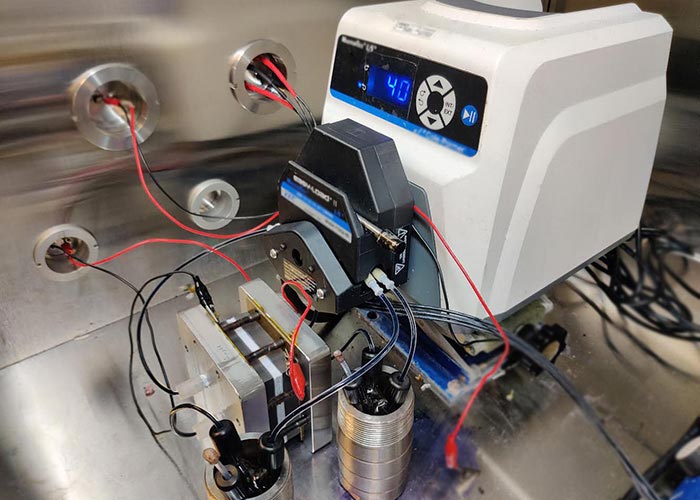New technique for large-scale energy storage developed by polymer scientist

Pictured here is a flow battery operating with the new catholyte as part of the technique Dr. Yu Zhu helped develop.
Credit: The University of Akron
The sale of electric vehicles (EV’s) has grown exponentially in the past few years as is the need for renewable energy sources to power them, such as solar and wind. There were nearly 1.8 million registered electric vehicles in the U.S. as of 2020, which is more than three times as many in 2016, according to the International Energy Agency (IEA).
Electric vehicles require power to be available anywhere and anytime without delay to recharge, but solar and wind are intermittent energy sources that are not available on demand. And the electricity they do generate needs to be stored for later use and not go to waste. That’s where Dr. Yu Zhu, a professor in The University of Akron’s School of Polymer Science and Polymer Engineering, and his research team come in, by developing a more stable way to store this important energy.
Just as the gas station today, electricity power stations need a storage system to keep the electricity for EV constantly charging. Low cost, scalable redox flow batteries (RFB) are among the most suitable technology for such a system; however, current RFBs use high-cost and environmentally hazardous active materials (electrolytes). Recently, water-soluble organic materials have been proposed as future electrolytes in the RFBs (namely aqueous organic RFBs, or AORFBs). Organic-based electrolytes can be obtained from renewable sources and manufactured with very low cost. However, the lack of stable water-soluble organic electrolyte materials, particularly the positive electrolyte (catholyte), is a major hurdle of AORFBs.
Zhu’s research group, in collaboration with scientists in Pacific Northwestern National Laboratory led by Dr. Wei Wang, successfully developed the most stable catholyte (positive electrolyte) to date in AORFBs and demonstrated cells that kept more than 90% of capacity over 6,000 cycles, projecting more than 16 years of uninterrupted service in a pace of one cycle per day. Their research was recently published in Nature Energy and included contributions from Zhu’s doctoral students Xiang Li and Yun-Yu Lai.
“Development of high-performance RFBs will enrich the category of electricity energy storage systems and complement the shortcoming of intermittent renewable energy sources, therefore largely improving the usability of electricity powered facilities, such as vehicles,” says Zhu. “To significantly improve the performance of aqueous organic RFBs, the urgency of developing new catholyte is crucial.”
In the Nature Energy paper, the team not only demonstrated a state of art catholyte in AORFBs, but also provided a brand-new strategy to design water soluble catholyte to enhance their solubility (energy density) in water. Instead of attaching a hydrophilic functional group to improve the solubility of the molecules, the researchers change the symmetry of molecules, which results in a dramatic enhancement of solubility. With the new design strategy, the team plans to design new materials they can further mature the RFBs.
A patent application has been submitted based on the technology developed in this research. The scalability of the materials will be further studied in Akron PolyEnergy Inc., a spin-out company from UA co-founded by Zhu that focuses on the development of materials in energy storage devices including lithium-ion batteries and flow batteries.
Journal: Nature Energy
Media Contact
Alexander Knisely
aknisely@uakron.edu
Office: 330-972-6477
All latest news from the category: Power and Electrical Engineering
This topic covers issues related to energy generation, conversion, transportation and consumption and how the industry is addressing the challenge of energy efficiency in general.
innovations-report provides in-depth and informative reports and articles on subjects ranging from wind energy, fuel cell technology, solar energy, geothermal energy, petroleum, gas, nuclear engineering, alternative energy and energy efficiency to fusion, hydrogen and superconductor technologies.
Newest articles

Machine learning algorithm reveals long-theorized glass phase in crystal
Scientists have found evidence of an elusive, glassy phase of matter that emerges when a crystal’s perfect internal pattern is disrupted. X-ray technology and machine learning converge to shed light…

Mapping plant functional diversity from space
HKU ecologists revolutionize ecosystem monitoring with novel field-satellite integration. An international team of researchers, led by Professor Jin WU from the School of Biological Sciences at The University of Hong…

Inverters with constant full load capability
…enable an increase in the performance of electric drives. Overheating components significantly limit the performance of drivetrains in electric vehicles. Inverters in particular are subject to a high thermal load,…





















